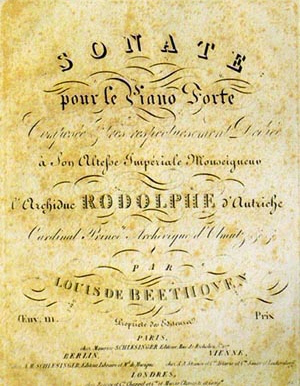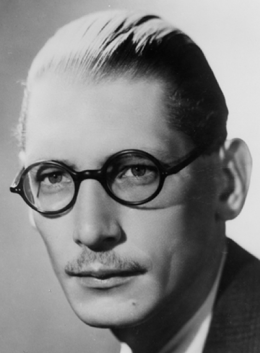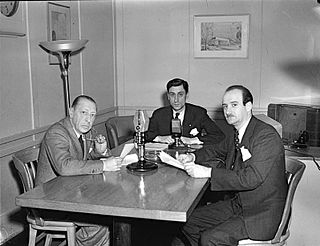Sonata form is a musical structure generally consisting of three main sections: an exposition, a development, and a recapitulation. It has been used widely since the middle of the 18th century.

Ludwig van Beethoven's Piano Sonata No. 29 in B♭ major, Op. 106 is a piano sonata that is widely viewed as one of the most important works of the composer's third period and among the greatest piano sonatas of all time. Completed in 1818, it is often considered to be Beethoven's most technically challenging piano composition and one of the most demanding solo works in the classical piano repertoire. The first documented public performance was in 1836 by Franz Liszt in the Salle Erard in Paris to an enthusiastic review by Hector Berlioz.

The Piano Sonata No. 32 in C minor, Op. 111, is the last of Ludwig van Beethoven's piano sonatas. The work was written between 1821 and 1822. Like other late period sonatas, it contains fugal elements. It was dedicated to his friend, pupil, and patron, Archduke Rudolf.

The Symphony of Psalms is a choral symphony in three movements composed by Igor Stravinsky in 1930 during his neoclassical period. The work was commissioned by Serge Koussevitzky to celebrate the 50th anniversary of the Boston Symphony Orchestra. The symphony derives its name from the use of Psalm texts in the choral parts.
G major is a major scale based on G, with the pitches G, A, B, C, D, E, and F♯. Its key signature has one sharp. Its relative minor is E minor and its parallel minor is G minor.
B-flat major is a major scale based on B♭, with pitches B♭, C, D, E♭, F, G, and A. Its key signature has two flats. Its relative minor is G minor and its parallel minor is B-flat minor.
G minor is a minor scale based on G, consisting of the pitches G, A, B♭, C, D, E♭, and F. Its key signature has two flats. Its relative major is B-flat major and its parallel major is G major.
D minor is a minor scale based on D, consisting of the pitches D, E, F, G, A, B♭, and C. Its key signature has one flat. Its relative major is F major and its parallel major is D major.
F-sharp minor is a minor scale based on F♯, consisting of the pitches F♯, G♯, A, B, C♯, D, and E. Its key signature has three sharps. Its relative major is A major and its parallel major is F-sharp major.
E-flat minor is a minor scale based on E♭, consisting of the pitches E♭, F, G♭, A♭, B♭, C♭, and D♭. Its key signature consists of six flats. Its relative key is G-flat major and its parallel key is E-flat major. Its enharmonic equivalent, D-sharp minor, contains the same number of sharps.
A-flat minor is a minor scale based on A♭, consisting of the pitches A♭, B♭, C♭, D♭, E♭, F♭, and G♭. Its key signature has seven flats. Its relative major is C-flat major, its parallel major is A-flat major, and its enharmonic equivalent is G-sharp minor.

The Piano Sonata No. 31 in A♭ major, Op. 110, by Ludwig van Beethoven was composed in 1821 and published in 1822. It is the middle piano sonata in the group of three that he wrote between 1820 and 1822, and is the penultimate of his piano sonatas. Though the sonata was commissioned in 1820, Beethoven did not begin work on Op. 110 until the latter half of 1821, and final revisions were completed in early 1822. The delay was due to factors such as Beethoven's work on the Missa solemnis and his deteriorating health. The original edition was published by Schlesinger in Paris and Berlin in 1822 without dedication, and an English edition was published by Muzio Clementi in 1823.

Sviatoslav Igorevich Soulima Stravinsky was a Swiss-American pianist, composer, and musicologist. As a pianist, he was considered an important interpreter of the works of his father, Igor Stravinsky, but as a composer he was overshadowed by his father.

The Piano Sonata No. 14 in C minor, K. 457, by Wolfgang Amadeus Mozart was composed and completed in 1784, with the official date of completion recorded as 14 October 1784 in Mozart's own catalogue of works. It was published in December 1785 together with the Fantasy in C minor, K. 475, as Opus 11 by the publishing firm Artaria, Mozart's main Viennese publisher.

Igor Stravinsky wrote the Ebony Concerto in 1945 for the Woody Herman band known as the First Herd. It is one in a series of compositions commissioned by the bandleader and clarinetist featuring solo clarinet, and the score is dedicated to him. It was first performed on March 25, 1946 in Carnegie Hall in New York City, by Woody Herman's Band, conducted by Walter Hendl.

The Octet for wind instruments is a chamber music composition by Igor Stravinsky, completed in 1923.
The Septet for clarinet, bassoon, horn, piano, violin, viola and cello is a Chamber music composition by Igor Stravinsky. It was composed between July 1952 and February 1953, and the first performance took place at Dumbarton Oaks in Washington, D.C., on 23 January 1954. The score is dedicated to the Dumbarton Oaks Research Library and Collection. It consists of three movements, the first lacking a title, and the last lacking a number in the score. The work is influenced by twelve-tone technique, especially by the Wind Quintet, Op. 26, and the Suite for septet, Op. 29, composed by Arnold Schoenberg.









